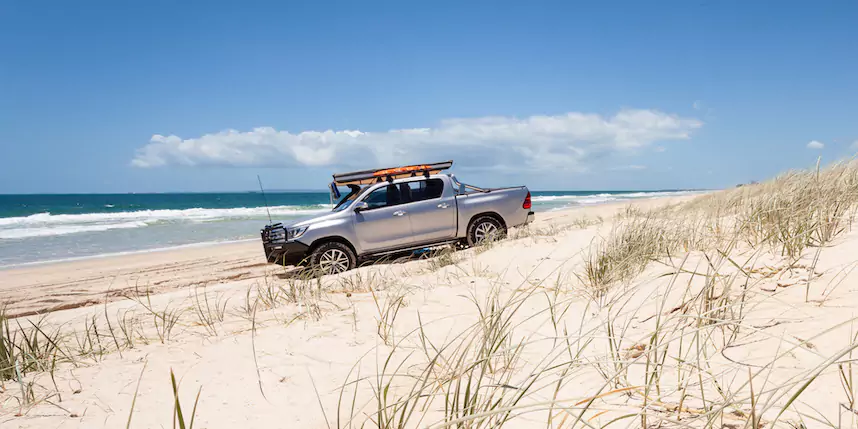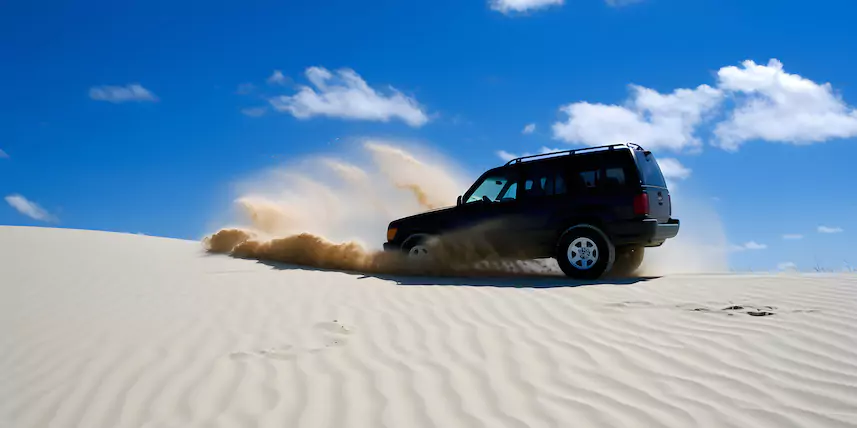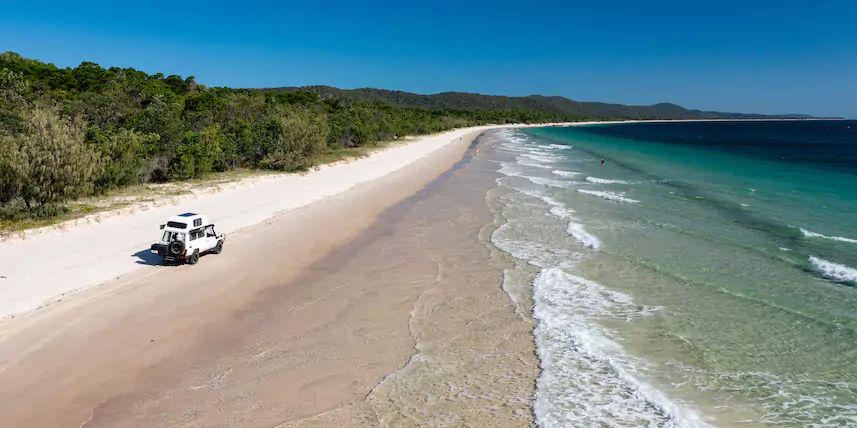Whether you love driving on the beach like me or enjoy heading out to the desert or dunes, I’ve found plenty of tips for driving on sand that will up your off-roading game.
Here, I have shared my favourite sand driving techniques and tricks I’ve learned through my years of off-roading experience.
Key Takeaways
- Adjust Tyre Pressure: Get to know how tyre pressure affects off-road driving sand driving
- Adjust Tyre Pressure: Adjust your tyre pressure between 8 and 20 psi depending on the sand conditions
- Recovery Preparedness: Carry essential recovery gear and know how to use it to get unstuck
- Road Rules: Follow all posted speed limits and adhere to the code off road
- Driving Technique: Keep a steady momentum to maintain forward motion and avoid abrupt or aggressive turns or stops
- Read the Terrain: Learn how to read your surroundings and make adjustments accordingly
- Use Tracks: Follow along in other 4×4 tracks for an easier ride
My Top Tips for Driving on Sand
| Tip | Explanation |
|---|---|
| Adjust Tyre Pressure | Driving on sand requires adjusting tyre pressure between 8 and 20 psi for better grip and traction. Constant monitoring and adjusting are necessary depending on the sand conditions. |
| Avoid Abrupt Movements When Steering | Keep steering gentle and smooth, especially with lower tyre psi to prevent tyres from rolling off the rim. |
| Have A Shovel and Proper Recovery Gear | Always carry a tyre deflator, snatch strap, pressure gauge, Maxtraxs, shovel, dampener, and an emergency kit for sand driving. |
| Know How to Get Unstuck | Use strategies like not fighting the sand, reversing, using a shovel, deflating tyres further, using Maxtraxs, and potentially a snatch strap with a dampener. |
| Drive Slow But Steady | Maintain a balance in speed, avoid sudden movements, and steer gently to prevent getting stuck in the sand. |
| Know and Follow the Road Rules | Adhere to speed limits, keep a safe distance, keep left, and give clear indications while driving on sand. |
| Learn How to Read The Terrain | Focus on the natural contours of the sand, reading slopes, and using the terrain to your advantage. |
| Use Previous Tracks to Your Advantage | Follow existing tracks when possible for a more stable path. |
1. Adjust Tyre Pressure
I’m listing tyre pressure first for a reason. When it comes to off-roading, tyre pressure is always one of the most important considerations. For driving on sand, tyre pressure is especially crucial.
I can almost guarantee that the wrong tyre pressure when driving on sand will have you spending the afternoon digging your 4×4 out.
Reducing the tyre pressure when driving on sand increases the amount of tyre surface area that is in contact with the sand. This provides better grip and traction and essentially helps your 4×4 float on the sand. The general recommendations for tyre pressure when driving on sand are between 8 and 20 psi.
Most people start around 20 psi and work their way down to a minimum tyre pressure of 12 psi, depending on the sand conditions. If needed, I go all the way down to 8 psi for added traction and control.
And remember, tyre pressure isn’t a “Set it and forget it” type of thing. I’m constantly keeping tyre pressure on my mind and adjusting it if needed.
For instance, imagine yourself driving along the beach. At first, the sand is wet and firm near the water and a tyre pressure around 20 psi is working perfectly.
Then, as you move towards drier, softer sand, your 4×4 begins to struggle. Once you’re a seasoned sand driver, you’ll know to reduce your tyre pressure and cut your chances of getting stuck.
You can learn more about tyre pressure in my ultimate 4WD tyre pressure guide.
2. Avoid Abrupt Movements When Steering
I’ve noticed that if I move the wheel too fast, especially when using lower tyre psi, the tyre is at risk of rolling off the rim.
I always keep my steering gentle and smooth and avoid harsh turns when I’m driving on sand. I’ve never rolled a tyre completely off the rim and I have no intentions of finding out what a nightmare it would be to fix.
3. Have A Shovel and Proper Recovery Gear
Whether I’m off-roading on sand, gravel, or mud, I’m always equipped with recovery gear. And if you’re driving in sand, I cannot recommend a shovel enough.
I’ve had a shovel save me a couple of different times and allow me to get back out and enjoy the rest of my afternoon.
When I’m driving on sand, there are a few recovery supplies I always have.
At a bare minimum, I recommend the following recovery gear for sand driving:
- A tyre deflator
- A snatch strap
- A pressure gauge
- Maxtraxs
- A shovel
- A dampener
- An emergency kit (jumper cables, flares, a first aid kit, bottled water, and a fire extinguisher)
4. Know How to Get Unstuck
Repeat after me: I’m going to get stuck at some point.
Getting stuck is an inevitable part of off-roading. But it doesn’t have to ruin your day.
The first step is having recovery gear (trust me, get a shovel!). And the next is knowing how to use your recovery gear when driving on sand doesn’t end well.
Here are tips for getting unstuck if you are stuck in sand:
- Don’t fight it. The more you spin your tyres and try to force your way forward, the deeper you’re going to sink.
- Try to get it backward. I’ve had a time or two where my tyres created a little back ramp that I could use to get out)
- Still stuck? Time to get out that shovel and use it to dig a ramp to get your 4×4 out
- Deflate your tyre pressure more if needed to get some increased traction
- Put your Maxtraxs under the tyres, hop in, and give it some throttle.
- If this doesn’t work, I grab a snatch strap (unfortunately, this requires a second vehicle to help you out)
- If I ever resort to using a snatch strap, I always use a dampener. This safety step helps stop a snatch strap from releasing and launching itself into one of the vehicles (this can have deadly consequences). Even a wet towel draped over the strap can work if you’re desperate.
5. Drive Slow But Steady
I’ve seen a couple of videos that show cars going too fast, making a sharp turn, and flipping when their tyres suddenly dig into the sand.
No thanks!
While it is important to keep enough momentum to propel your 4×4 forward, driving on sand is not the time to set speed records. The higher your speed, the higher your risk of digging in and sinking.
Along with finding the right balance of speed — not too slow, not too fast — I recommend keeping your steering, turns, and movements gentle.
I remember cruising along the beach with my friend, who was fairly new to off-roading. We were heading into the sun, so there was a bit of a glare. Suddenly, he noticed a pile of debris up ahead and slammed on the brakes.Good on him for not rumbling over the debris. But we were definitely stuck!
Stomping on the brakes causes a rapid sand buildup in front of the tires. Most of the time, this means you aren’t going anywhere for a while!
We were able to get unstuck fairly quickly. And sometimes the best way to get better at driving on sand is making mistakes just like this.
But my friend learned one of the most important sand driving techniques that day — slow and steady is the way to go.
Sand is a tricky surface and any sudden or aggressive movements can have you stuck.
Here are some sand driving techniques for keeping it smooth, slow, and steady:
- Don’t go too slow – maintain a steady momentum.
- When coming to a stop, never stomp on the brakes.
- Do not make abrupt stops unless absolutely necessary.
- If you feel your 4×4 starting to drag, slowly apply more throttle to try to stay moving and adjust your gears if necessary.
- If you notice debris or a wash out on the beach and need to avoid it, try to steer around it rather than slamming on your brakes.
6. Know and Follow the Road Rules
I love seeing nothing but sand stretching out in front of me.
But driving on the sand isn’t a free-for-all. Just like driving on tarmac, there are road rules to follow, including:
- Adhere to any speed limits (unless posted, the default speed limit in WA is 20 km/h)
- Keep a safe distance when travelling behind other vehicles (I stay at least 3 to 4 vehicle lengths away)
- Keep left on beaches (sure, there are no posted lanes but driving on sand on the beach means traffic is two-way)
- Give a clear indication of which side you are going to pass on
For a more detailed look at WA Road Rules, sand driving techniques, and off-roading safety, I recommend these sites:
7. Learn How to Read The Terrain
Some sand driving techniques are easy to implement. Others, like learning how to read the terrain, can take years to master. Still, I find myself more confident in this tip every time I’m driving on sand.
I focus on paying attention to the natural contours of the sand, reading the slopes, and using the terrain to my advantage.
A lot of this is almost automatic for me now. I can make subtle adjustments to the momentum of my vehicle according to the terrain — without even thinking much about it.
It reminds me of a game of chess, where good players are always several moves ahead of their opponent.
Picture yourself far out in the desert and ready to turn your 4×4 around to head back. An unseasoned off-roader may attempt to come to a stop, turn around, and get going again. This may work. Or it may not.
For me, I always take advantage of any natural slopes when I need to turn around. I keep up my momentum, drive part way up the slope, and then make the turn. It allows me to work with the landscape rather than against it.
Of course, only do this at the very base of subtle slopes. Never climb a dune and attempt to turn around. Your high-side springs will be trying to unload even though your low-side springs are compressed. This can result in a rollover.
8. Use Previous Tracks to Your Advantage
I love laying the first tracks and forging my own path. But there are times I follow in existing tracks. Using ruts from other vehicles that have gone through can make it so much easier to enjoy a steady, smooth cruise.
If you want to follow other 4×4 tracks, use the existing ruts that are most compacted. Following these ruts will give you the most solid path to follow.
More of My Favourite Sand Driving Techniques
Here are a few of my favourite sand driving techniques:
- Try using low-range 4WD – I find this provides improved torque when driving on the sand
- In automatic vehicles, I’ve noticed the car usually does a decent job engaging the right gear. Sometimes I’ll switch to manual mode if I notice the automatic gearbox isn’t choosing the appropriate gear for the sand conditions
- If you’re beach driving, pay close attention to the tides (to learn more about beach driving safety, read our beach driving post)
- Restore the tyre pressure before heading back to tarmac
- When I’m driving on dunes, I always fly a high vis flag in front of my 4×4 to help improve my visibility to other vehicles
- Never traverse across a sand dune (straight up, straight down)
- Give your 4×4 a quick hose down after beach driving to get rid of salt on top and underneath the vehicle
- Between the high revs and low tyre pressure, driving on the sand isn’t easy on the fuel tank. Always head out with a full tank and carry fuel reserves if you’re travelling long sandy stretches.
- Keep an eye on your engine temp as it may run hotter than normal when driving in the sand. Always check /top off your fluids before you head out.
Conclusion
If my sand driving tips have you ready to get out there, there are some awesome sand driving options in my guide to the best 4WD tracks in Perth. If you haven’t checked out the towering sand dunes at Lancelin, put that at the top of your list!
Is your 4WD in need of a tune up or some modifications before you head out? Our Perth 4×4 experts can get you all set up to conquer sand driving.
We’re obsessive about 4x4s, so we know all the important 4×4 modifications you need for successful off-roading. With everything right on-site in our Perth shop, we can modify your 4×4 in house. Contact us with any questions or to book a 4×4 servicing or modification appointment.



